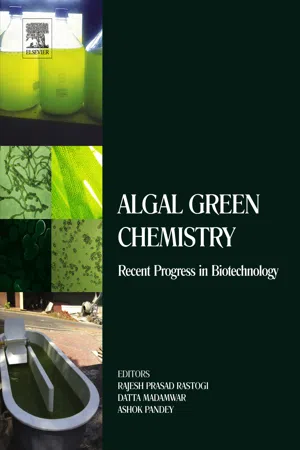
Algal Green Chemistry
Recent Progress in Biotechnology
- 336 pages
- English
- ePUB (mobile friendly)
- Available on iOS & Android
Algal Green Chemistry
Recent Progress in Biotechnology
About This Book
Algal Green Chemistry: Recent Progress in Biotechnology presents emerging information on green algal technology for the production of diverse chemicals, metabolites, and other products of commercial value. This book describes and emphasizes the emerging information on green algal technology, with a special emphasis on the production of diverse chemicals, metabolites, and products from algae and cyanobacteria.
Topics featured in the book are exceedingly valuable for researchers and scientists in the field of algal green chemistry, with many not covered in current academic studies. It is a unique source of information for scientists, researchers, and biotechnologists who are looking for the development of new technologies in bioremediation, eco-friendly and alternative biofuels, biofertilizers, biogenic biocides, bioplastics, cosmeceuticals, sunscreens, antibiotics, anti-aging, and an array of other biotechnologically important chemicals for human life and their contiguous environment. This book is a great asset for students, researchers, and biotechnologists.
- Discusses high-value chemicals from algae and their industrial applications
- Explores the potential of algae as a renewable source of bioenergy and biofuels
- Considers the potential of algae as feed and super-food
- Presents the role of triggers and cues to algal metabolic pathways
- Includes developments in the use of algae as bio-filters
Frequently asked questions
Information
Osmoprotectant and Sunscreen Molecules From Halophilic Algae and Cyanobacteria
Abstract
Keywords
1. Introduction
2. Osmoprotectants and Sunscreen Molecules (MAA)
2.1. Basic Features of Osmoprotectants in Cyanobacteria and Algae
2.2. Saccharides and Their Derivatives
2.2.1. Glucosylglycerol and Glucosylglycerate
Table of contents
- Cover image
- Title page
- Table of Contents
- Copyright
- Contributors
- Editor's Biography
- Preface
- Chapter 1. Osmoprotectant and Sunscreen Molecules From Halophilic Algae and Cyanobacteria
- Chapter 2. UV Photoprotectants From Algae—Synthesis and Bio-Functionalities
- Chapter 3. Genome- and Proteome-Wide Analyses for Targeted Manipulation and Enhancement of Bioproducts in Cyanobacteria
- Chapter 4. Nutraceuticals From Algae and Cyanobacteria
- Chapter 5. Natural Antioxidants From Algae: A Therapeutic Perspective
- Chapter 6. Microalgae as a Source of Bioplastics
- Chapter 7. Microalgae-Based Carotenoids Production
- Chapter 8. Low-Molecular-Weight Nitrogenous Compounds (GABA and Polyamines) in Blue–Green Algae
- Chapter 9. Algal Pigments for Human Health and Cosmeceuticals
- Chapter 10. Role of Algae as a Biofertilizer
- Chapter 11. Modeling and Technoeconomic Analysis of Algae for Bioenergy and Coproducts
- Chapter 12. Polyamines: Stress Metabolite in Marine Macrophytes
- Chapter 13. Microalgal Biomass Cultivation
- Chapter 14. Algal Biofilms and Their Biotechnological Significance
- Index